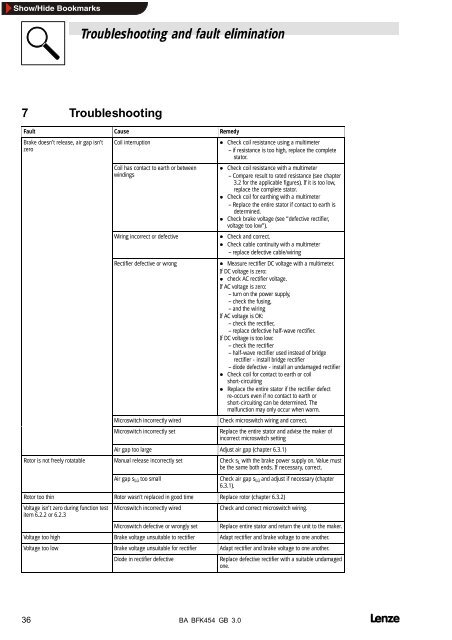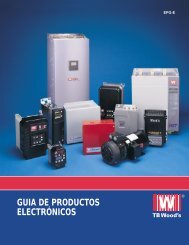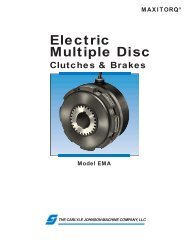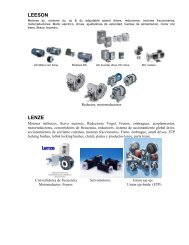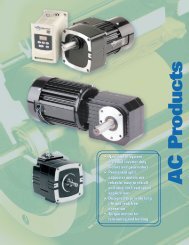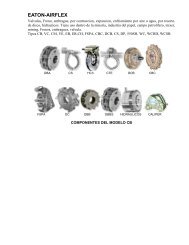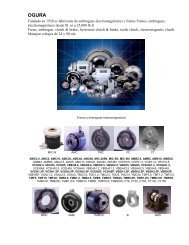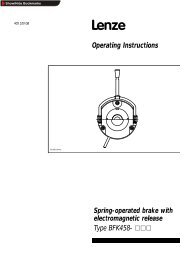Lenze BA14.0169 Spring Operated Brake BFK ... - Southern Power
Lenze BA14.0169 Spring Operated Brake BFK ... - Southern Power
Lenze BA14.0169 Spring Operated Brake BFK ... - Southern Power
- No tags were found...
You also want an ePaper? Increase the reach of your titles
YUMPU automatically turns print PDFs into web optimized ePapers that Google loves.
Troubleshooting and fault elimination<br />
7 Troubleshooting<br />
Fault Cause Remedy<br />
<strong>Brake</strong> doesn’t release, air gap isn’t<br />
zero<br />
Coil interruption<br />
Coil has contact to earth or between<br />
windings<br />
Wiring incorrect or defective<br />
Rectifier defective or wrong<br />
Microswitch incorrectly wired<br />
Microswitch incorrectly set<br />
l Checkcoilresistanceusingamultimeter<br />
– if resistance is too high, replace the complete<br />
stator.<br />
l Check coil resistance with a multimeter<br />
– Compare result to rated resistance (see chapter<br />
3.2 for the applicable figures). If it is too low,<br />
replace the complete stator.<br />
l Check coil for earthing with a multimeter<br />
– Replace the entire stator if contact to earth is<br />
determined.<br />
l Check brake voltage (see ”defective rectifier,<br />
voltage too low”).<br />
l Check and correct.<br />
l Check cable continuity with a multimeter<br />
– replace defective cable/wiring<br />
l Measure rectifier DC voltage with a multimeter.<br />
If DC voltage is zero:<br />
l check AC rectifier voltage.<br />
If AC voltage is zero:<br />
– turn on the power supply,<br />
– check the fusing,<br />
– and the wiring<br />
If AC voltage is OK:<br />
– check the rectifier,<br />
– replace defective half-wave rectifier.<br />
If DC voltage is too low:<br />
– check the rectifier<br />
– half-wave rectifier used instead of bridge<br />
rectifier - install bridge rectifier<br />
– diode defective - install an undamaged rectifier<br />
l Check coil for contact to earth or coil<br />
short-circuiting<br />
l Replace the entire stator if the rectifier defect<br />
re-occurs even if no contact to earth or<br />
short-circuiting can be determined. The<br />
malfunction may only occur when warm.<br />
Check microswitch wiring and correct.<br />
Replace the entire stator and advise the maker of<br />
incorrect microswitch setting<br />
Air gap too large Adjust air gap (chapter 6.3.1)<br />
Rotor is not freely rotatable Manual release incorrectly set Check s L with the brake power supply on. Value must<br />
be the same both ends. If necessary, correct.<br />
Air gap s Lü too small<br />
Check air gap s Lü and adjust if necessary (chapter<br />
6.3.1).<br />
Rotor too thin Rotor wasn’t replaced in good time Replace rotor (chapter 6.3.2)<br />
Voltage isn’t zero during function test<br />
item 6.2.2 or 6.2.3<br />
Microswitch incorrectly wired<br />
Microswitch defective or wrongly set<br />
Check and correct microswitch wiring.<br />
Replace entire stator and return the unit to the maker.<br />
Voltage too high <strong>Brake</strong> voltage unsuitable to rectifier Adapt rectifier and brake voltage to one another.<br />
Voltage too low <strong>Brake</strong> voltage unsuitable for rectifier Adapt rectifier and brake voltage to one another.<br />
Diode in rectifier defective<br />
Replace defective rectifier with a suitable undamaged<br />
one.<br />
36 BA <strong>BFK</strong>454 GB 3.0


